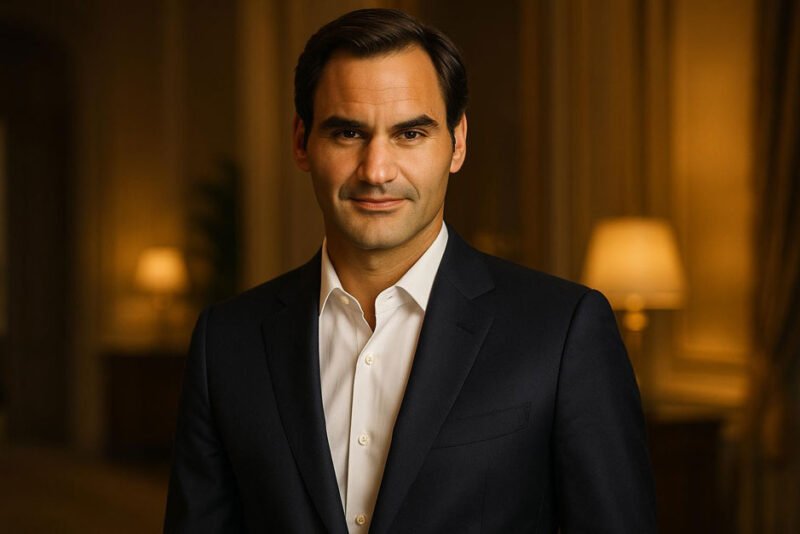Roger Federer has transcended the boundaries of professional tennis to become one of the wealthiest athletes in history. The Swiss maestro, who gracefully retired from competitive tennis in 2022, has achieved something few athletes ever accomplish: billionaire status.
His journey from a promising junior player to a global icon worth over $1 billion represents one of the most successful athlete-to-business transformations in sports history. Federer’s financial success extends far beyond his impressive on-court achievements, showcasing a masterclass in strategic brand building and smart investments.
Roger Federer’s Current Net Worth in 2025
Roger Federer’s net worth currently stands at an estimated $1.1 to $1.3 billion, according to recent reports from Forbes and Bloomberg. This remarkable figure places him among an exclusive group of just seven athletes who have achieved billionaire status.
The tennis legend officially joined the billionaire club in 2025, marking a significant milestone in his post-retirement financial journey. His wealth has continued to grow even after stepping away from professional tennis, demonstrating the enduring power of his personal brand.
Federer’s billionaire status makes him the seventh athlete in history to reach this financial pinnacle. He joins an elite group that includes basketball legends Michael Jordan, Magic Johnson, and LeBron James, golf icon Tiger Woods, and former Milwaukee Bucks player Junior Bridgeman.
Tennis Career Earnings and Prize Money
Throughout his illustrious 24-year professional career, Federer accumulated approximately $130.6 million in prize money. While this figure represents a substantial sum, it accounts for only a small fraction of his total wealth.
His on-court achievements were nothing short of extraordinary. Federer claimed 20 Grand Slam singles titles, including eight Wimbledon championships and five US Open victories. He spent 310 weeks as the world’s number one ranked player and won 103 ATP tournaments.
Despite earning less prize money than rivals Novak Djokovic ($189 million) and Rafael Nadal ($135 million), Federer’s total earnings far exceeded both players. His prize money ranks third in tennis history, but his overall financial success tells a different story entirely.
The Swiss champion’s final tournament victory came at the 2019 Swiss Indoors in Basel, his hometown event where he once served as a ball boy. This emotional triumph marked the end of his trophy-winning career, though his financial success was just beginning to peak.
Lucrative Endorsement Deals and Sponsorships
Federer’s endorsement portfolio reads like a luxury brand catalog, featuring partnerships with some of the world’s most prestigious companies. His carefully cultivated image as tennis royalty made him an ideal ambassador for high-end brands seeking sophistication and elegance.
Rolex has been one of his most enduring partnerships, reportedly paying him $8 million annually. The Swiss watchmaker’s association with Federer perfectly aligned with both parties’ commitment to precision and excellence. This relationship has continued well into his retirement years.
Mercedes-Benz provides another $5 million annually to the tennis icon, while luxury chocolate maker Lindt contributed $20 million throughout their partnership. These long-term relationships demonstrate the stability and trust brands place in Federer’s marketability.
His most significant endorsement move came in 2018 when he left Nike after a 20-year partnership. The decision to sign with Japanese retailer Uniqlo for $300 million over ten years proved to be financially transformative. This deal alone guaranteed him $30 million annually, regardless of his playing status.
The Game-Changing On Investment
Perhaps no single business decision has been more impactful to Federer’s wealth than his investment in Swiss shoe company On. This strategic move has generated more money for the tennis legend than his entire Grand Slam prize money combined.
The investment opportunity arose in an unexpectedly personal way. Federer first discovered On when his wife began wearing the company’s running shoes. Intrigued by the brand’s innovative approach to athletic footwear, he reached out directly to the company’s founders.
In 2019, Federer acquired approximately a 3% stake in the Zurich-based company. At the time, On was primarily focused on running shoes but had ambitious plans to expand into other athletic categories. Federer wasn’t content to be a passive investor, actively participating in product development.
The gamble paid off spectacularly when On went public on the New York Stock Exchange in 2021. The company’s market capitalization has since grown to nearly $17 billion, with shares rising 86% from their initial public offering price.
Federer’s stake in On is now valued between $375 million and $500 million, depending on current market conditions. This single investment has proven more lucrative than his entire tennis career earnings, demonstrating the power of strategic business partnerships.
Other Business Ventures and Investments
Beyond his On investment, Federer has diversified his portfolio across various sectors. In 2021, he participated in a $235 million Series D funding round for NotCo, a Chilean company developing plant-based food alternatives using artificial intelligence.
The NotCo investment, which valued the startup at $1.5 billion, featured other celebrity investors including Formula 1 driver Lewis Hamilton. This venture represents Federer’s interest in sustainable food technology and his willingness to support innovative startups.
His investment strategy extends beyond individual companies to include real estate and other traditional wealth-building vehicles. Federer has maintained partnerships with financial institutions, including UBS bank, which acquired his former sponsor Credit Suisse in 2023.
The tennis icon continues to work with more than a dozen partners from his playing days. These relationships include private jet operator NetJets and luxury eyewear brand Oliver Peoples, demonstrating the lasting value of his personal brand.
Federer Among Billionaire Athletes
Federer’s entry into the billionaire club places him in extraordinarily exclusive company. He becomes only the second tennis player to achieve this milestone, following Romanian Ion Țiriac, who won the 1970 French Open doubles championship.
Țiriac, who began investing after the fall of communism, joined the billionaires list in 2007 and currently has an estimated net worth of $2.3 billion. His success came through diversified investments in real estate, car dealerships, and financial services.
Among active athletes, only LeBron James and Tiger Woods had previously achieved billionaire status while still competing. Federer’s post-retirement ascension to this level demonstrates the enduring power of a well-managed athletic brand.
The complete list of billionaire athletes showcases the diverse paths to extreme wealth in sports. Michael Jordan leads with $3.8 billion, followed by Magic Johnson at $1.5 billion, and Tiger Woods at $1.3 billion.
The Business Strategy Behind the Fortune
Federer’s financial success stems from a carefully orchestrated strategy that began early in his career. His approach focused on building long-term relationships with premium brands rather than chasing short-term maximum payouts.
His marketing appeal transcends tennis, embodying sophistication, reliability, and excellence. These qualities made him attractive to luxury brands seeking to associate with his refined image and spotless reputation.
The decision to leave Nike for Uniqlo exemplified his strategic thinking. By partnering with a company that didn’t produce tennis shoes, he created an opportunity to pursue the lucrative On investment without conflicting brand loyalties.
Federer’s social media presence remains remarkably strong for a retired athlete. With 43.5 million followers across major platforms, he maintains higher engagement rates than many active players, ensuring continued marketing value for his partners.
Looking Forward: The Federer Legacy
Roger Federer’s transformation from tennis champion to business mogul offers valuable lessons for athletes and entrepreneurs alike. His success demonstrates that athletic excellence can serve as a foundation for broader business achievements when combined with strategic thinking and careful brand management.
The timing of his major business moves proved crucial to his financial success. His decision to invest in On just before the company’s explosive growth, coupled with his strategic endorsement choices, created a perfect storm of wealth accumulation.
As Federer continues to enjoy retirement, his business empire shows no signs of slowing down. His investments continue to appreciate, his endorsement deals remain active, and his global appeal endures years after his final match.
The Swiss legend’s journey from a three-year-old picking up his first tennis racket to a billionaire businessman represents one of sports’ greatest success stories. His net worth of over $1 billion stands as testament to the power of combining athletic excellence with smart business decisions.
For aspiring athletes and business leaders, Federer’s path offers a blueprint for building lasting wealth that extends far beyond any single career or achievement. His story proves that with the right strategy, vision, and execution, the sky truly is the limit.









